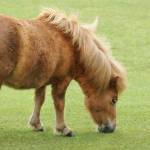Using Grazing Muzzles on Horses

For some horses and many ponies, grazing muzzles can be considered costume de rigueur for much of the year. In many cases, grazing muzzles are life-saving apparatuses, especially for those equines that are susceptible to laminitis.
Grazing muzzles greatly reduce the amount of pasture a horse or pony can consume. These devices generally have one or two holes on the floor of the muzzle. Muzzles can be customized to allow more or less forage consumption, but the animal should be able to drink without restriction.
The muzzle should be attached to a breakaway halter and fit should be double-checked often. The extra weight of the muzzle adds more pressure to the bridge of the nose than usual, and pressure sores might develop. Encasing the noseband in fleece will provide relief.
Most horses tolerate a muzzle, though some do not and will attempt whatever means necessary to remove it. For those horses that manage to remove the muzzle often, thereby putting themselves at risk, the only option may be a drylot.
Because horses nip and bite to express dominance, herd dynamics might be affected when a muzzled horse is placed in a group among unmuzzled ones. Careful observation of the group will reveal if problems are imminent. Regrouping horses might be the only way to alleviate social tension among the horses if infighting persists.








